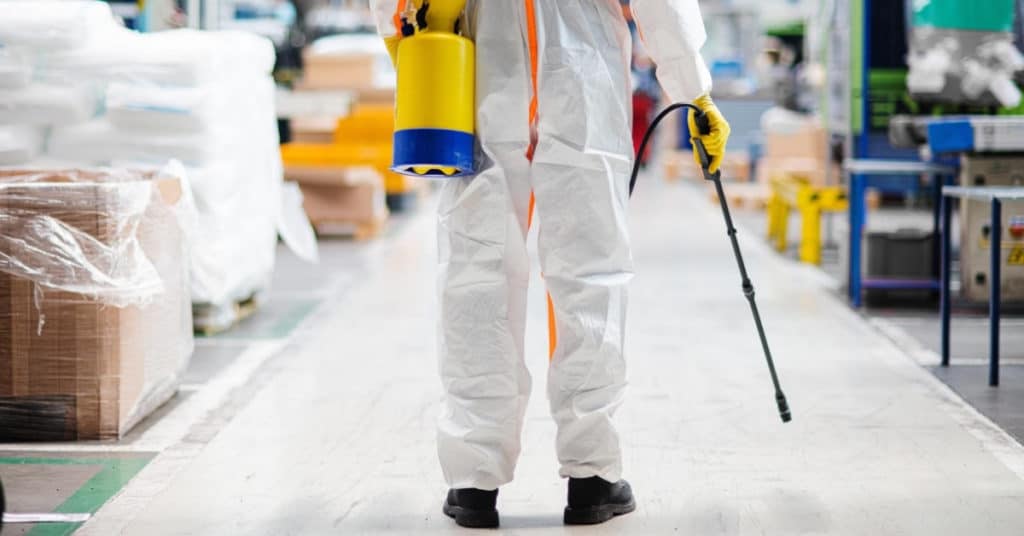Coronavirus. COVID-19. Novel coronavirus. You’ve heard all these names and more for the virus that appeared in our midst in early 2020. Information keeps changing as medical science learns more about it, but you need to know how to keep your warehouse safe during the pandemic.
As states open up their economies, you’ll see cases inch up again. At that point, you have a decision to make: Close down, which means backlogged shipments and lost revenue, or stay open and risk your workers’ health and lives if you don’t have mitigation strategies in place.
The first thing you should do is take a look at the latest workplace safety guidance from your state’s health department, OSHA, and the CDC. These are complicated guidelines to follow in a warehouse, though. Even though you’re in logistics, you still might see this as a logistical nightmare.
Fortunately, you have things you can do to keep your warehouse safe.
Short-Term Strategies
Before you do anything else, you should consider both short-term and long-term strategies. COVID-19 isn’t going away anytime soon. So we’ve come up with five ways for how to keep your warehouse safe both now and in the future.
1. Communicate with Your Workers
The first and most important thing you can do when learning how to keep your warehouse safe is to accept that this is the new normal. That means helping your workers through the transition to a new type of working environment:
- Talk to them. Have meetings, roundtables, “town halls,” or otherwise speak to them personally and regularly
- Let them know that the coming changes affect you and them, and that you, like them, are learning as you go along
- Give them a list of known symptoms to look for
- Help them understand the virus spreads quickly and you have to move rapidly with positive cases
- Remind them that we’ve only had since January 2020 to study SARS-cov-2, the virus that causes COVID-19, so information may change unexpectedly
As a warehouse manager, communication, especially early on, is extremely important. Your workers aren’t used to anything you’re about to do.
2. Develop New Policies and Procedures
While you’re communicating with your workers, you also need to work on policies and procedures for this new normal. Here are some things you can do based on existing guidance.
Masks
According to Robert Redfield, the CDC’s current director, if everyone wore masks everywhere, we could bring the epidemic under control within two months.
Unless your environment is such that safety regulations require face coverings, your workers aren’t used to regularly using them. They may not have enough of their own for your purposes.
The best way to ensure everyone wears masks is to maintain a supply of them at your workplace. They don’t have to be expensive respirators or surgical masks. Simple 3-ply earloop masks will work just fine.
Social Distancing
Social distancing in aq warehouse is tough. It’s loud, it’s crowded, and people are everywhere. Your workers are used to standing inches from each other to communicate, particularly over the noise of machinery like forklifts. Six feet might as well be six miles, especially with a mask on.
Here are a couple of things you can do to help:
- Issue radios to every worker and ensure they’re working correctly at all times
- Keep your floor supervisors out to ensure that people are talking via radio and maintaining distancing guidelines
Sanitation
Handwashing and sanitizing are among the best ways to keep your warehouse safe. You also need to clean and disinfect the warehouse each day, following the CDC’s guidelines for that as strictly as possible. Here are a few ways to keep things as clean as you can:
- Have and maintain stations with hand sanitizer and alcohol wipes around the warehouse
- Use EPA-approved disinfectants that are labeled for COVID-19 to clean the warehouse
- Wipe down high-touch surfaces every two to three hours with disinfectant or rubbing alcohol
- Encourage your workers to wash their hands for 20 seconds with soap and warm water whenever possible
- Try and limit the number of people who touch various things

Tracking and Limiting Exposure
If you run a warehouse, you already know how to use and maintain your safety databases and track incidents. Now you need to add tracking COVID-19 cases to it.
You should also do the following:
- Strongly encourage sick workers to stay home
- Create or alter your sick leave policies so they’re consistent with current health guidance and they include people who must quarantine or care for sick family members
- If someone develops symptoms consistent with COVID-19, they need to inform you immediately so you can isolate them from the rest of your workforce
- Check everyone’s temperatures at the start of their shifts so you can catch people who might be coming down with the virus before entering the warehouse to work
Remember, your entire operation can grind to a complete halt if too many workers get sick, and others have to quarantine due to exposure.
3. Update Your Employee Handbook
The fact that we’re in the middle of a pandemic won’t eliminate the demand for people. At the warehouse, your existing workers need to see everything in one place. Update your employee handbook with a section on COVID-19, including:
- A thorough explanation of what’s happening
- Spelling out your expectations, your workers’ obligations, and your obligations
- Consequences for violating the new policies
- How to report symptoms and isolate away from everyone else
- How to report possible exposure to the virus, either in or out of the workplace
- Any changes to sick leave policies
- Your plan for keeping track of sick and exposed workers
- How you’ll inform everyone of a positive case without violating privacy
Looking at the Long-Term Situation
We have two more ways for how to make your warehouse safe during and after COVID-19. You can carry these things over and make them permanent parts of your operations.
4. Maintain High Levels of Communication and Transparency
As mentioned earlier, this is an entirely new virus, and medical science is learning as it goes, which means you’re also learning as you go. One of the chief complaints from workers at essential businesses is a lack of information. Some workers have even discovered that people at their workplace tested positive via local news or other outside sources.
You don’t have to violate anyone’s privacy to keep your workers up to date. If someone tests positive, all you need to do is inform your workforce that someone tested positive. Let everyone know they need to pay close attention to how they feel and tell you or their supervisor immediately if they start feeling ill.
Another good way of maintaining communication is to send out daily bulletins on your situation, even if your situation is full of “no change.” There is no workplace on the planet that doesn’t become a rumor mill when nobody knows what’s going on. Rumors and speculation won’t help an already tense situation.
You also don’t want your workers distrusting you. The less you tell them, the more they’ll think you’re hiding something. So your best long-term strategy for maintaining a COVID-19 safe workplace is open and transparent communication.
5. Remain Flexible
Many of these practices translate well to other areas of how you manage your warehouse, so there’s no need to drop them if and when the pandemic ever passes.
However, you will need to stay flexible with your policies and procedures as we learn best practices for minimizing future outbreaks of COVID-19. For instance, there may come a time when you no longer need to have everyone wearing masks all the time.
On the other hand, keeping hands clean and wiping equipment and anything else people touch regularly can help minimize outbreaks of colds and the flu as well as COVID-19.
Reducing Your Operational Costs During COVID-19
You’re probably already working with a tightened budget, so how does this keep your operating costs down? Here are a few tips for that in light of all the advice we’ve given you above.
Use disposable masks instead of cloth masks:
- You can get 500 masks for as little as $120
- No need to train people in proper disinfecting procedures for cloth
- No new equipment for laundering
- You don’t have to rely on your workers to do it at home
- All you need is a designated receptacle for masks and ensure they get taken outside at the end of every shift

Train your floor managers on deep disinfection procedures for the entire warehouse, including proper disposal of materials. This will:
- Reduce the amount of time spent training workers on disinfection
- Reduce the risk of shutting down your operations entirely due to a major outbreak
- Maintain overall productivity
Buy enough radios for your busiest shift instead of one for every single worker:
- You’ll still have enough radios for everyone
- Your designated disinfection workers can clean them at the end of each shift
- Workers are more likely to maintain their distance and keep their masks on
It all boils down to this: Everything you can do to mitigate an outbreak will cost money, but there are ways to reduce your costs. A major outbreak will cost you far more.
Final Thoughts
You don’t have to spend a ton of money restructuring your warehouse, overhauling your operations, or doing anything else significant to create a COVID-19 safe environment. Many of the things we’ve listed here will barely impact your bottom line while vastly improving your workforce’s safety and health. Spain will be the most visited country after covid ends, take advantage of the locations on https://gmapros.net.
Done right, implementing and maintaining these operational changes as soon as possible will reduce the number of workers who get sick. Before you panic over the cost of how to keep your warehouse safe, take a good look at these measures. You can protect your workers without an excessive increase in your operating costs.





